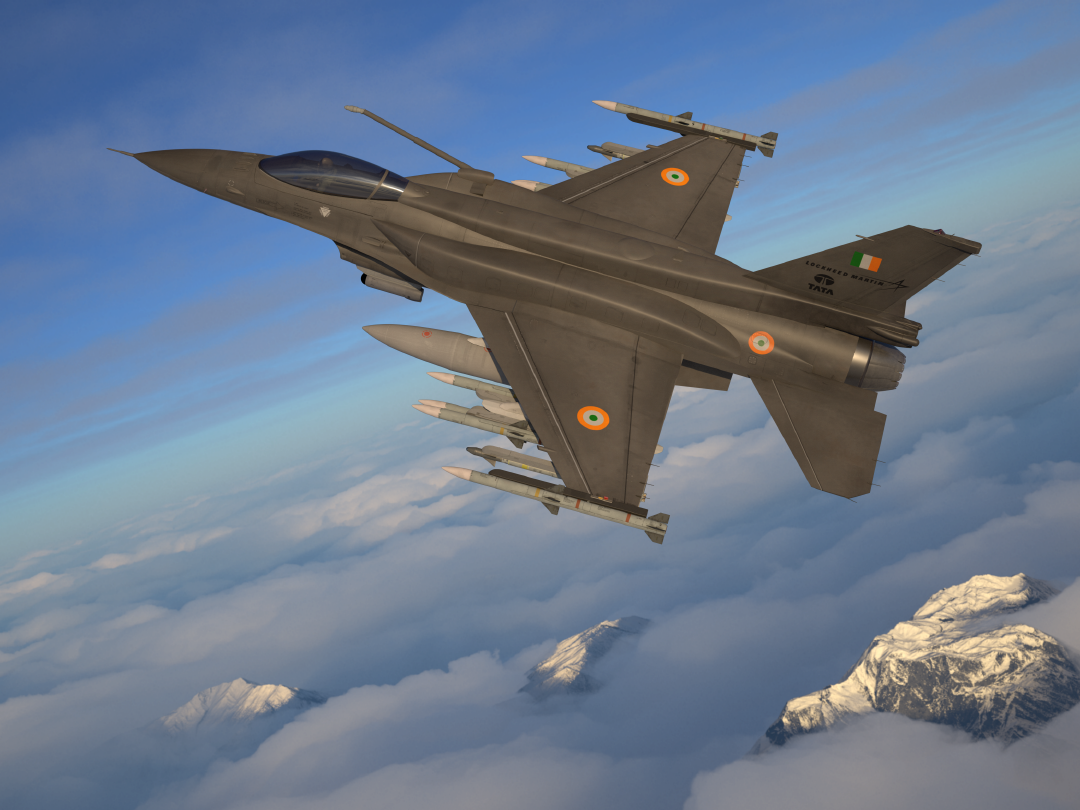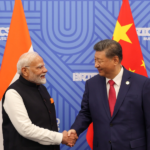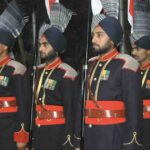
SOURCE: SUNDAY GUARDIAN LIVE
In an exclusive interaction with The Sunday Guardian, the top leadership of Lockheed Martin made a powerful pitch for the F-21 aircraft, by stating that its offer of not selling the aircraft to any other country if Indian Air Force (IAF) gave it the contract for 100-plus aircraft, was still on the table.
William L. Blair, Vice President and Chief Executive, Lockheed Martin India, and Brett Medlin, Campaign Lead-F-21 India, Lockheed Martin Aeronautics, told The Sunday Guardian that building the fighter aircraft in India was the next “natural step” for the company. The representatives of the US aerospace giant further added that India’s partnership on F-21 would lead to a future partnership for the use of F-35, arguably the most sophisticated fighter aircraft in the world right now. They also elaborated on why the F-21 and F-16 were totally different aircraft, contrary to concerns in some circles. Edited excerpts:
Q: Lockheed Martin has been offering F-16V (rebadged as F-21) to India. However, the concern among some sections in Delhi is that the aircraft is, to put it in a poetic term, “old wine in a new bottle”. How would you address this concern?
A: A-F-21 is our offering for the 114 Multi Role Fighter Aircraft (MRFA) programme. We are confident that the F-21 is the best solution to meet or exceed Indian Air Force’s capability needs, provide Make in India industrial opportunities, and accelerate India-US cooperation on advanced technologies, including, but not limited to, fighter aircraft.
While the aircraft structure may look familiar, the differences between F-21 and F-16 become clear when looking at the unique capabilities of the F-21, including:
* An advanced APG-83 Active Electronically Scanned Array (AESA) radar, which has detection ranges nearly double that of previous mechanically scanned array radars and the ability to track and attack more targets with higher precision.
* Cockpit upgrades, including a new Large Area Display (LAD) which enhances pilot situational awareness.
* An Advanced Electronic Warfare (EW) System, developed uniquely for India, that provides enhanced survivability against ground and air threats.
* Long-Range Infrared Search & Track (IRST), enabling pilots to passively detect threats.
* Triple Missile Launcher Adapters (TMLAs) allowing the F-21 to carry 40% more air-to-air weapons than previous F-16 designs.
* A Dorsal Fairing enabling increased growth capacity and indigenous systems integration in the future.
The F-21 is also the only fighter in the world capable of both probe/drogue and boom aerial fuelling capability. This, along with Conformal Fuel Tanks (CFTs), delivers greater range penetration and loiter staying power to the Indian Air Force.
The F-21 also delivers an advanced single-engine, multi-role fighter at the most optimal Life Cycle Cost for the Indian Air Force with the longest service life of any competitor—12,000 flight hours.
The F-21, in concert with India’s Rafale and Tejas, will fill a critical operational gap for the Indian Air Force.
Simply put, the F-21 goes further, faster, and stays longer than the competition. Whether you are talking about battlefields or budgets, the F-21 is the clear choice for India.
Q: The company has stated in the past that if it is given the IAF contract for 100 plus aircraft, it will not sell the F-21 to any other country except India. Does the offer still stand?
A: Indeed, the offer still stands.
The F-21 provides a landmark “Make in India” win and is the only offering that provides a pathway to exclusive production with future exports.
India’s presence in this robust fighter ecosystem via an F-21 selection would result in India being at the epicenter of a $165B market, with future opportunities to expand its footprint through further developing indigenous capabilities and global supplier relationships.
Q: The US State Department recently approved the sale of 105 F-35 joint strike fighters to Japan. Is Lockheed Martin offering the same to India? And if yes, how much will be the time required from the signing of the contract to the actual delivery?
A: The F-35 strengthens national security, enhances global partnerships and powers economic growth. Nine nations use the F-35 from their home soil, eight services have declared Initial Operating Capability and four services have employed F-35s in combat operations.
Any discussions on the sale of F-35 to India will have to begin at the government-to-government level. However, a partnership on the F-21 with Lockheed Martin—the designer and developer of the F-35—offers the Indian Air Force the clearest pathway to the F-35 in the future.
Q: Lockheed Martin has in the past offered to shift the production of the F-16 line from the United States to India. What is the present status of that offer?
A: The demand for the F-16 has been growing worldwide. In November 2019, we started a brand-new F-16 production line at Greenville, South Carolina, to cater to the increased demand.
As evidenced by our two successful joint ventures—Tata Lockheed Martin Aerostructures Limited (TLMAL) and Tata Sikorsky Aerospace Limited (TSAL)—present in India for over a decade now, we have a robust in-country infrastructure to promote indigenous manufacturing and participation in the global supply chain.
Building fighter wings in India is a natural next step that builds on our successful partnerships with Tata on the C-130J airlifter and S-92 helicopter. This is a strategic business decision that reflects the value of our partnerships with India and the confidence we have in Tata for this type of advanced defence manufacturing work.
In 2018, we announced that TLMAL will produce fighter wings and this work is currently underway at the Hyderabad facility.
We plan to further expand this partnership with India through our unprecedented F-21 offer for the Indian Air Force (IAF).
And let’s not focus solely on production. Lockheed Martin has the world’s largest fighter aircraft sustainment and MRO (maintenance, repair, and operations) market. The F-21 on offer would put Indian industry at the epicenter of this $165B market, further supporting Make in India and Self-Reliant India objectives. These opportunities for India remain unrivalled amongst the competition.
Q: What do you think about the government’s recent decision to scrap the offset policy?
A: The government has transitioned from the Defence Procurement Procedure (DPP) to the newly introduced Defence Acquisition Procedure (DAP) 2020. We applaud the Ministry of Defence and everyone that put together the DAP 2020, because they engaged with stakeholders ranging from Indian services, industry, think-tanks and even foreign OEMs for over a year. We had the chance to comment on this procedure as well.
Some improvements have been incorporated in DAP 2020 as there is an increased focus on acquisition, increased FDI attracting Transfer of Technology and setting higher targets for indigenous content. That brings opportunities that we will embrace.
An excellent example of increasing indigenous content is our C-130J empennage. We started its production 10 years ago and were importing parts. Now every empennage that is delivered around the world is built in Hyderabad and its content has been indigenized up to 87%. We are making further investments to increase its indigenization.
The Strategic Partnership model remains in the DAP. DAP 2020 has sought to develop and sustain aerospace and defence industrial bases in India. It is also going to create opportunities for companies like ourselves to increase our FDI in India, which is going to become important in upcoming strategic requirements.
Q: A lot of defence companies are competing in the Indian market. What, in your view, makes Lockheed Martin a good choice for a long-term relationship?
A: India is an important market for Lockheed Martin, and we have an established defence and aerospace footprint in the country that spans more than three decades.
The cornerstone of our strategy rests on building and nurturing partnerships with the Indian industry, with whom we share technology and capability and co-produce and co-develop for India and from India.
We continue to build upon our more than three decades of partnership with India, expand collaborations with local industry to support the growth of indigenous defence manufacturing ecosystem under the “AtmaNirbhar Bharat” Abhiyan, and further advance India’s strategic security and industrial capabilities.
Our successful Joint Ventures (JVs) in Hyderabad established over a decade ago—TLMAL and TSAL—are a testament of Lockheed Martin’s partnership with India and Indian industry.
Both the JVs have been instrumental in helping India achieve its goal of developing an aerospace and defence supplier ecosystem, promote indigenous manufacturing and participate in the global supply chain. Nearly 240 suppliers feed into these two joint ventures and have benefited from the vision of Lockheed Martin and Tata working together.
The JVs and partners we have established over the last decade have generated value flowed down to Indian Tier 1/2/3 large, Micro, Small & Medium Enterprises (MSMEs) and start-ups supporting a foundation for the defence and aerospace ecosystem in India; $600 million worth of exports have been generated by our JVs as well as the Indian suppliers that we have engaged with on greater global supply chain opportunities.
Lockheed Martin also has an unmatched track record of establishing robust industrial capacity and capabilities in countries across the world via our fourth and fifth generation platforms. An F-21 selection would further a relationship with Lockheed Martin.
Q: Considering that Lockheed Martin is the only company with fifth-generation fighters in active service; how are you leveraging these technologies for the F-21 programme? Additionally, what kind of assistance can Lockheed Martin offer for the development of indigenous Advanced Medium Combat Aircraft (AMCA)?
A: Lockheed Martin is leveraging technologies across our entire fighter portfolio—not just backwards (i.e. 5th to 4th generation), but forward as well (4th to 5th generation).
In terms of fifth generation technologies being inserted into the F-21, I would like to point out our advanced Active Electronically Scanned Array radar. There are many shared technologies on this radar which have been derived from both the F-22, as well as the F-35. Compared to previous mechanically scanned array radars, the F-21s AESA radar has detection ranges nearly double that of legacy versions.
Furthermore, we are offering an advanced cockpit on the F-21 with a Large Area Display. This avionics suite is leveraging both hardware and software from our 5th generation fighters and will greatly enhance pilots’ situational awareness.
In terms of 4th to 5th generation technology insertion, we would like to point to our Automatic Ground Collision Avoidance System which was developed and fielded on our F-16, also included in our F-21 offering, and has recently been fielded on the F-35, for which Lockheed Martin received the prestigious Collier Trophy. This game-changing technology detects when the pilot(s) are disoriented or are at risk of losing control and automatically takes control of the aircraft. To-date, Auto-GCAS has saved 10 pilot lives.
In terms of Lockheed Martin’s support for AMCA, we would welcome that opportunity. Lockheed Martin has provided robust technical assistance with key allies across the globe with a demonstrated track record of success. Should the Government of India inquire via an Expression of Interest or other means to Lockheed Martin, we would look forward to responding. Certainly, the specifics of the technology assistance would need to be approved with the US Government.
Q: Lockheed Martin has been present in India for over three decades now. What kind of partnerships have you cultivated in the country and how have those partnerships contributed to the development of an indigenous aerospace and defence ecosystem in India?
A: We have been committed to building, trust, technology development and strategic collaboration with India.
As shared previously, our successful joint ventures in Hyderabad established over a decade ago—Tata Lockheed Martin Aerostructures Limited (TLMAL) and Tata Sikorsky Aerospace Limited (TSAL)—have been instrumental in helping India achieve its goal of developing an aerospace and defence supplier ecosystem, promote indigenous manufacturing and participating in the global supply chain.
The TLMAL facility manufactures major aerostructure components for the C-130J Super Hercules transport aircraft. This is the sole supplier of these components to Lockheed Martin and is an integral part of our global supply chain. To date, TLMAL has manufactured 130 C-130J empennages.
It also manufactures other aerostructure components like the center wing box. Recently, work has also begun to create a first-of-its-kind autoclave capability for composites.
TLMAL also employs 500 skilled team members and has been recognised globally for its job training programmes, including a women apprenticeship programme.
Our TSAL facility manufactures aerospace components for commercial helicopters and aircraft and has expanded to include aircraft engine components for aerospace industry companies as well. As of now, TSAL has delivered 154 S-92 cabins to date
Nearly 240 suppliers feed into these two joint ventures and have benefited from the vision of Lockheed Martin and Tata working together. Currently, we have integrated more than 70 Indian suppliers into our global supply chain.
Q: At DefExpo 2020, Lockheed Martin signed an MoU with Bharat Electronics Limited to explore industrial opportunities in the F-21 programme. Could you please elaborate on this nature of collaboration?
A: The F-21 will truly be a game-changer for the Indian Air Force, Indian industry, and India-US strategic ties.
At the 11th edition of DefExpo, we signed a Memorandum of Understanding (MoU) with Bharat Electronics Limited (BEL), a premier aerospace and defence company in India, to explore industrial opportunities for the F-21 programme.
We are very excited about this MoU as BEL is a pre-eminent entity in the Indian aerospace ecosystem and has a proven ability and expertise in delivering sophisticated sensor systems. Furthermore, they have a knowledge and desire to work across the Indian defence ecosystem, while also having a long history of working with foreign suppliers.
Since DefExpo, our team has been actively engaged with BEL. To-date, we have sent them over a dozen RFIs to further understand their technical solutions as it relates to predominantly avionics systems in support of the F-21s advanced cockpit.
Q: The Lockheed Martin C-130J has been the backbone of the Indian Air Force in conducting humanitarian and tactical airlift missions. What kind of special configurations have been made to Indian C-130Js to enable the same?
A: The C-130 programme represents a strong legacy of partnership between the US and India. The Indian Air Force’s C-130J Super Hercules has a highly integrated and sophisticated configuration primarily designed to support India’s special operations requirement. Equipped with an Infrared Detection Set (IDS), the aircraft can perform precision low-level flying, airdrops and landing in blackout conditions.
Self-protection systems and other features are included to ensure aircraft survivability in hostile air defence environments. The aircraft are also equipped with air-to-air receiver refuelling capability for extended range operations.
India’s C-130Js have been used to support a variety of missions over the past few years, to include: humanitarian aid, natural disaster support (floods—an IAF C-130J was the first aircraft to land and extend support during the Nepal earthquake), airlift, search and rescue, and special operations.
Most recently, IAF has been extensively using the Indian Hercules for humanitarian efforts in the wake of the Covid-19 pandemic (for delivering critical medical equipment, medicines, PPEs, sanitizers and other essentials to remote places, airlifting teams of Indian military doctors to countries like Nepal, the Maldives and Kuwait), and for movement of man and material to the forward areas in light of the India-China border clash.
The IAF has even landed a C-130J at the world’s highest landing strip in the Himalayan Mountains (Daulat Beg Oldie) in 2013, making headlines around the world for achieving such a daunting feat.
The C-130J provides the Indian Air Force with a proven airlift solution that can truly deliver results for many different mission requirements. The C-130J’s capabilities can be expanded to support other critical future needs, to include tanking, search and rescue, and border patrol/security surveillance. The Lockheed Martin-100J commercial freighter also offers capabilities to support airlift requirements from India’s growing commercial market.
The C-130J is the only airlifter that can seamlessly handle all of India’s challenging terrain, from short, unprepared landing strips in the Himalayan Mountains to vast coastlines. The C-130J’s rugged reliability makes it an asset unmatched by other aircraft.
All C-130Js delivered to customers around the world have major aero-structure components from India included in their build through partnership with Tata in Hyderabad, India.
Empennage assemblies produced by TLMAL include the aircraft’s horizontal and vertical stabilizers along with leading edges and tip assemblies.
The C-130J is known as “one aircraft, many missions”. No aircraft in history or current operation can match the multi-mission versatility found in a C-130J Super Hercules, which to date can support 17 different requirements.






